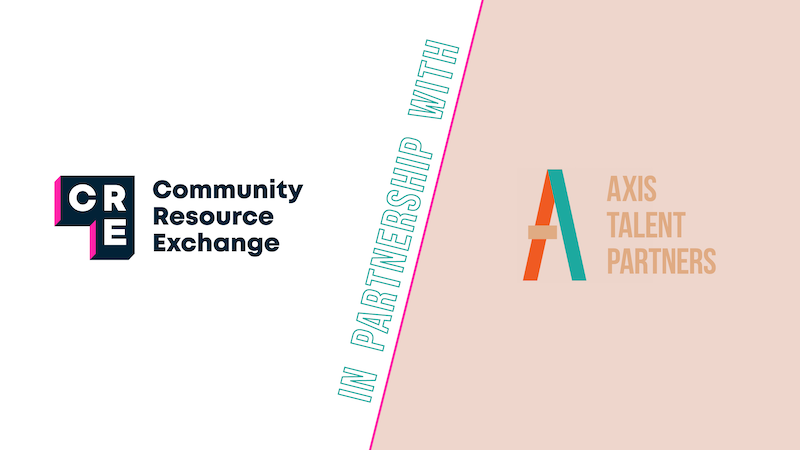
Laura Donald, CEO of Axis Talent Partners
Tiloma Jayasinghe, President and CEO of Community Resource Exchange
Leadership, in the social impact sector and in general, is inherently transitional, characterized by stages of change and evolution. The question isn’t whether leadership transitions will happen—they will. The real challenge lies in how we respond to and prepare for these transitions. We know too, that the demands of leadership in our field have become untenable for individual leaders. If we don’t rethink how we structure and support nonprofit leadership, including how we plan for leaders to exit the organizations they lead, we could face a critical shortage of social impact leaders, and potentially unravel the hard-won progress our sector has made in increasing the diversity in our ranks and the impact of our work.
As women of color leaders, we think constantly and care deeply about the future of leadership in our sector. And we’re concerned. Collectively, we’ve spent decades leading in, building capacity with, and recruiting executives for nonprofit organizations. Our work has shown us what nonprofit leaders need, not just to survive but thrive in their roles. We hear from leaders time and again that nonprofit leadership is often about steering through turbulence and constant change. These leaders must overcome financial shortfalls, repair dysfunctional team dynamics, adapt to shifting funder priorities, and navigate unionization processes—often all at once. More than ever, non profit leadership has become unsustainable for many, with leaders often sacrificing personal health, wellness and relationships under the weight of their roles.
For leaders of color, these challenges are magnified by additional pressures and glaring inequities, including the weight of expectations from communities of color who have long awaited representation at the top.
Leadership transitions are not only inevitable, they are often needed and even healthy. We can embrace these moments as opportunities for renewal, versus crises. By better supporting leaders before and during these pivotal times, we can actually foster long-term, sustainable leadership both within an organization as well as across the sector as a whole.
In this three-part series, we’ll share insights on what to stop doing and, crucially, what to start doing to better navigate and manage leadership transitions, with a focus on equity and inclusion, in the nonprofit world. Let’s start thinking differently about how we support leadership so we can preserve and nurture the leaders of now, the leaders to come, and the progress we’ve made as a movement. This moment – of financial insecurity, continuing post pandemic depletion, and ever-widening political division – when real change is needed as much as ever, requires all of us as a social impact community to imagine a new paradigm.
Here is our first offering.
Stop doing this: Keep executive transitions secret
Do this instead: Succession plan from Day 1
We know this sounds risky, but one of our top recommendations is to stop shrouding executive leadership transitions in secrecy and viewing it as a risk to organizational outcomes, relationships, funders, and stability. Instead, we invite leadership teams and boards to bring succession planning out in the open and to the start of a new leader’s tenure so that you can:
- Position an organization to adopt practices that contribute to healthy organizational cultures
- Ensure leadership development pathways and visible opportunities to advance
- Promote clear and transparent communication
- Offer opportunities for engagement of the larger team about what the organization needs.
- Invest executive directors in developing leadership capacities in themselves and their teams as an explicit and shared priority.
These practices don’t just reimagine how to set up a productive and healthy executive leader transition, they are also cornerstone examples of equity-centered cultures, which for us, simply translate as best practices for how to engage and invest in all people fairly. Or put another way, how you demonstrate authentic care for the humans delivering on the mission. We know already that all of us do better when we feel connected and cared for.
Normalize Transitions & Transition Planning:
With succession planning normalized and begun early in a leader’s tenure, Executive Directors and Boards are better empowered to lead through transitions, at a characteristically fraught and shaky stage. And the organization is better positioned to navigate change with stability. Leadership development and succession work build organizational capacity and resiliency. They also allow for a paradigm shift around the perceived threat of Executive Director transition.
 Like early succession planning, transitions can also be normalized. They can be framed as expected and important stages for both the individual and the organization. Thoughtful transition planning – that includes organizational assessment and preparation for an equity-focused executive search process – helps set up an organizational community to experience transitions as opportunities for organizational evolution, innovation, growth, and even celebration.
Like early succession planning, transitions can also be normalized. They can be framed as expected and important stages for both the individual and the organization. Thoughtful transition planning – that includes organizational assessment and preparation for an equity-focused executive search process – helps set up an organizational community to experience transitions as opportunities for organizational evolution, innovation, growth, and even celebration.
Relieving the burden of traditional transition planning for Executive Directors which is often characterized by secrecy and lack of support (along with the guilt and self doubt that often surrounds this period), can go a long way toward lifting the heaviness of the leadership load, and supporting their stamina for future leadership chapters.
We view this first recommendation, this invitation, as a transformative opportunity. We know it sounds hard, but trust us, it is possible. While not the norm, we have seen it done effectively. The opportunity for new leaders to step into a paradigm where they are intentionally developing leaders around them, supporting their own tenures, as well as, positioning the organization for stability and resilience when they transition is a powerful way to set up a leader and an organization for success. Succession planning as an early, clear expectation signals care for both the incoming leader and the broader staff. This action which boards and funders can facilitate and resource, communicates an important shift away from a transactional dynamic with the organizations they govern and fund to one that is more human and care-centered.
Our next offering is an unapologetic non-negotiable for both ourselves and our organizations and also incredibly powerful in paradigm-shifting. Stay tuned for what that is (or take your best guess).



